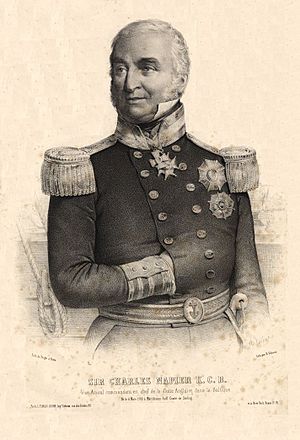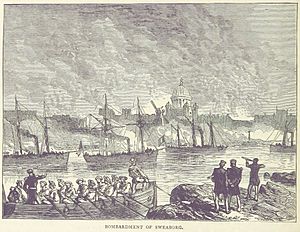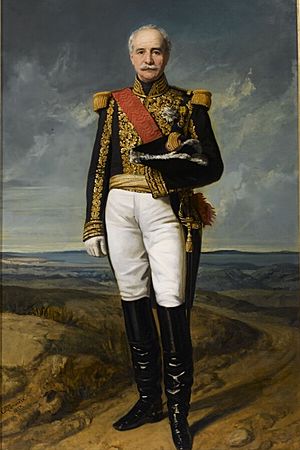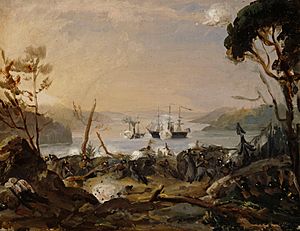Åland War facts for kids
Quick facts for kids Åland War |
|||||||
|---|---|---|---|---|---|---|---|
| Part of the Crimean War | |||||||
 A sketch of the quarter deck of HMS Bulldog in Bomarsund, Edwin T. Dolby, 1854 |
|||||||
|
|||||||
| Belligerents | |||||||
The Åland War (also known as the Oolannin sota in Finnish) was a series of battles that took place from 1854 to 1856. It was part of the larger Crimean War. During this time, a combined British and French naval force attacked military and civilian places. These attacks happened along the coast of the Grand Duchy of Finland. Finland was then a part of the Russian Empire.
The war gets its name from the Battle of Bomarsund in Åland. But fighting also happened in other Finnish coastal towns. These towns were located in the Gulf of Bothnia and the Gulf of Finland.
The main goal of the Åland War was to stop Russia's trade routes. Britain and France wanted to force Russia to make peace. They also hoped to get Sweden to join the war against Russia. The plan was to block Russian ships in the Baltic Sea. They aimed to destroy coastal forts, naval ships, and trade warehouses. Finland suffered a lot of damage. This was because many merchant ships flying the Russian flag were based in Finland. Finland had been an independent Grand Duchy under Russian rule since 1809.
This war had a big impact on the future of Åland. It led to the islands becoming a demilitarized zone. This means no military forces or bases are allowed there.
Contents
Starting the Åland War

The British Navy set sail for the Baltic Sea on March 11, 1854. Vice Admiral Sir Charles Napier led this force. It included nine modern steam-powered ships and many other vessels. French troops were led by General Achille Baraguey d'Hilliers. The French Navy was under Vice Admiral Alexandre Parseval-Deschenes.
The war officially began on March 27. The British-French fleet had about one hundred ships. They were very modern for their time, using steam power. This allowed them to trap the Russian fleet. The Russian Navy mostly stayed near their sea forts for protection. Most of the Allied attacks were aimed at the Grand Duchy of Finland. Some of the very first Victoria Crosses were given to sailors from this British-French fleet.
By June 1854, the threat from the British-French navy was clear. Finland needed a stronger army. Interim Governor-General Platon Rokassowski agreed to create a new army. At the start of the war, Finland had only a small number of soldiers. Russia's own fleet was quite old. It could not fight effectively in open waters. Instead, Russian ships were used to protect important ports like Viapori (now Suomenlinna) and Kronstadt. By 1855, Finland had a reserve army to support its main forces.
Battles During the War
Fighting in Åland
In the late summer of 1854, British and French ships attacked the Bomarsund fortress in Åland. This fort was still being built. The naval division surrounded it and eventually captured it. In early September, the fort was blown up. The ships' cannons had a longer range than the fort's guns. This meant the ships could destroy the fortress from a safe distance.
Battles in the Gulf of Bothnia
Rear-Admiral Sir James Hanway Plumridge led a naval division into the Gulf of Bothnia. His mission was to destroy Russian military supplies. Fighting happened in many coastal towns between 1854 and 1855. The main battles were in Rauma, Oulu, Raahe, Tornio, and Kokkola.
Admiral Plumridge had told Captain George Giffard to block the Gulf of Bothnia. The British War Minister, the Duke of Newcastle, wanted to avoid destroying towns that could not defend themselves. But Captain Giffard took some actions on his own. The damage caused in Raahe even led to a debate in the British Parliament. Some groups, like the Quakers, raised money to help the people of Raahe. A road in Raahe, "Kveekarintie" (Quakers road), was built with this money.
From Uusikaupunki to Pori
In June 1855, British ships reached Uusikaupunki (Nystad in Swedish). A British ship warned the town that it would be bombed if soldiers were present. Russian troops were stationed nearby. The British captured one ship and burned 14 others in the port. On July 6, the town's optical telegraph station was bombed. This happened because the town could not provide fresh meat the navy demanded. A few people were killed, and small fires started.
A British warship entered the port of Rauma on July 2, 1855. The mayor tried to negotiate but refused to hand over ships. The British landed about a hundred men. They set fire to warehouses and ships. However, Russian Cossacks and local guards fought back. The British had to retreat. Swedish newspapers reported seven British soldiers killed. The British reported six injured, with two later dying. After the landing force left, the warship fired on Rauma for 2.5 hours. Many shots were fired, but they did not cause much damage to the town.
The British and Rauma people had different stories about what happened. The British claimed the mayor had tricked them. They also said the fighting was due to a misunderstanding and language problems. The mayor of Rauma was very upset. He complained to the Russian War Minister. Three weeks later, on July 24, two British warships returned to Rauma. They fired on the town and landed sailors. These sailors set fire to port buildings and timber. Rockets and bombs were fired until late at night. The town itself was not badly damaged. But in the port, 54 buildings and a lot of shipbuilding timber were destroyed.
The town of Björneborg (Pori in Finnish) was first attacked in late summer 1854. An enemy ship destroyed an optical telegraph mast at the outer port. They also took property from local people. The enemy did not approach the city center until August 9, 1855. The British warship Tartar arrived. Pori had a small number of Russian soldiers and volunteers. But the mayor, after talking with citizens, decided not to fight. Pori had been badly damaged by a big fire three years earlier. They did not want to risk more destruction. The cannons were rolled into the river. The mayor negotiated with the enemy. He agreed to hand over a steamship and other vessels. In return, Pori would be saved. Some people thought the actions of Pori's citizens were shameful.
From Kristinestad to Nykarleby
At the start of the war, soldiers and cannons protected Kristinestad. But in spring 1855, the soldiers left. They took their rifles and hid the cannons. On June 27, British steamships arrived. They destroyed empty cannon positions. They threatened to shell the town, its timber depot, and shipyard. After talks, the shelling was avoided. The British received a ship and food supplies. The ships returned in mid-July for more food. After that, the enemy did not visit Kristinestad again.
In 1854, Vasa was spared from attack. This might have been because its harbor channels were hard to navigate. Also, the British knew the city had been destroyed by fire two years earlier. In autumn 1855, on August 3, a British ship anchored near the port of Palosaari. An empty house was burned because the British thought Russian soldiers had stayed there. They also seized two ships and burned another new one. The British tried to take tar supplies. But Russian soldiers arrived to defend the port. The British ship moved out of range.
On August 8, the British attacked Palosaari port with two armed boats. This attack became part of a local legend. British boats fired cannons and rockets, setting some buildings on fire. Russian and Finnish soldiers defended the shore. Sharpshooters fired from the roof of a warehouse, forcing the British boats to retreat. A Russian artillery unit arrived to help. The next day, the British ship left, taking two captured vessels. The port had only minor damage. One Russian and one Finnish soldier were killed.
Nykarleby was completely untouched by the war. Enemy ships visited its outer harbor. But the captains of captured ships gave false information. They said there were many artillery batteries and soldiers in Nykarleby. This likely made the enemy decide not to attack.
From Jakobstad to Tornio
Enemy ships first approached Jakobstad in July 1854. But they could not reach the port because channel markers had been removed. Later, in July 1854, two British captains visited the inner harbor. They talked with the mayor, Gabriel Tengström. He convinced them that Jakobstad had no valuable government property. The mayor's strong attitude also made the British expect tough resistance, like in Kokkola. In November, another British ship arrived. It seized a merchant ship and tried to land troops. But a Russian artillery unit forced the landing boats to return. On November 13–14, Jakobstad was fired upon for a few hours. But the shots caused no damage.
British ships arrived off Kokkola on June 7, 1854. The commander demanded ships and supplies from the port. In what is known as the Skirmish of Halkokari, local citizens, armed by a trade counselor, fought back. They pushed back a British landing party. Before the British came to Vaasa, two Russian companies had arrived to help Kokkola. The British tried to land in Kokkola again the next year. But their attack was stopped without much damage.
The British squadron destroyed ships and tar stores in Raahe on May 30, 1854. They did the same in Oulu on June 1. In Raahe, the British landed easily. They burned 13 ships being built, a tar storage area, and a pitch burner. They also burned construction timber, salt, and 7,000 barrels of tar. This later caused problems for them. The tar they burned had been ordered and paid for by English merchants. The British visited Oulu again on June 3. They demanded firewood and threatened to burn the city. All cargo boats were sunk, but 12 cords of wood were given to the British. After June 4, the British ships split up. Some sailed to Tornio and others to Kokkola.
The local government in Oulu estimated the damage at over 380,000 rubles. This included ships, tar, warehouses, and shipyards. The biggest losses were suffered by G. Bergbom, who lost over 100,000 rubles. In total, 53 people in Oulu suffered losses.
Battles in the Gulf of Finland

In the Gulf of Finland, the British naval squadron attacked Suomenlinna (Sveaborg in Swedish) for two days. People in Helsinki watched from the shore. Finnish naval troops operated coastal cannons. The British Navy also fired rockets at Suomenlinna. This was reportedly the first time rockets were used in war in Finland. One of these rockets is now in the War Museum in Helsinki. The Svartholm fortress near Loviisa was also bombed. The Ruotsinsalmi sea fortress, which had no defenders, was almost completely destroyed.
End of the War
The British had planned an even larger fleet for the Baltic Sea for the third summer. They wanted to gather over 250 ships. But the Crimean War ended before they could do this. The Åland War ended when the Crimean War finished. The British then destroyed the Bomarsund Fortress. They had first offered this fortress to Sweden. This was to reward Sweden for staying neutral and to ease fears about Russia's future actions.
For Britain and France, Bomarsund Fortress was a symbol of Russia's growing power. They felt it threatened Stockholm, the capital of Sweden. Offering the fortress to Sweden, then destroying it, showed Britain's power. It also showed their ability to stop Russia's expansion.
In the Paris Peace Treaty of 1856, the British demanded that Russia keep Åland unfortified. This meant no military bases or defenses. The demilitarization of Åland continued even after First World War. The League of Nations finally confirmed Åland belonged to Finland. This was based on historical documents. Åland had been ruled from Turku, not Stockholm, during Swedish rule. In return for Åland belonging to Finland, Finland had to guarantee the Ålanders' self-government and cultural rights.
The fortification of Åland was discussed again in 1938–1939. The Soviet Union wanted to protect its Baltic Sea areas from possible German attacks. Even after the Second World War, Åland remained a demilitarized region.
The Crimean War experience led to big changes in Russia. Czar Alexander II started major social reforms. He aimed to modernize and industrialize Russia.
The Oolannin sota Song
The Finnish song "Oolannin sota" (Åland War) was created in the 1850s. The person who wrote the lyrics or music is unknown. The "fästninki" mentioned in the song refers to the Bomarsund fortress.
This song is very popular. For a long time, its origin was a mystery. But in the 21st century, researchers found out more. The original version of the song was found in a handwritten songbook from the 1850s. It was likely written by unknown Bomarsund soldiers. These soldiers became prisoners of war in England. The song mentions prisoners of war in Lewes, England. Researchers think the writer might have been Johan Wallenius. He was a surgeon in Bomarsund.
The original song described the defeated battle realistically. It was changed into its current form in the early 20th century. The new version does not mention Bomarsund's surrender. The current lyrics first appeared in a songbook in 1911. The original language of the song was Finnish. The earliest known Swedish version is from 1925. In Åland itself, the song is still not well known today.
See also
- Baltic Medal
- Battles of the Crimean War
- The Finnish Prisoner
Images for kids





